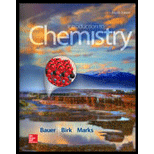
Interpretation:
The fate of the world if the hydrogen bonding becomes very weak and the boiling point of water falls to
Concept Introduction:
One of the important intermolecular forces present in the polar molecules is the hydrogen bonding force. Hydrogen bonding is observed for molecules having hydrogen atom covalently bonded to a more electronegative atom such as nitrogen or oxygen or fluorine and another molecule having an unshared pair of electron on nitrogen or oxygen or fluorine atom. Hydrogen bonding is stronger than the London dispersion force and the dipole-dipole force.
The boiling point of a liquid is the temperature at which the vapor pressure of that liquid becomes equal to the surrounding pressure. At the boiling point, the liquid changes its state to vapor. The boiling point of a substance depends on the intermolecular forces present in the liquid state of that substance. The stronger the intermolecular forces, the higher is the boiling point of the liquid.
Want to see the full answer?
Check out a sample textbook solution
Chapter 10 Solutions
Introduction to Chemistry
- 5) Who was responsible for the first model of the atom that included electrons? a. Dalton b. Thomson c. Bohr d. Rutherford 6) Which of the following rate laws is a fourth-order reaction? a. r = k[X][Y]²[Z] b._r= k[X]²[Y]³ C. r = k[X][Y]² d._r= k[X][Y]²[Z]ª 7) The activation energy of a particular reaction will decrease if: a. A catalyst is used. b. Temperature is increased. c. Reactant concentration is increased. d. All of the abovearrow_forwardpls helparrow_forwardState the reason why compound A (m.p. 99-100°C) is heated under vacuum.1. So that the sample heating temperature is not too high when heated under vacuum.2. So that the temperature is higher than the melting point of compound A.3. So that cold water is not required in the sublimator.arrow_forward
- To find the theoretical % yield of a given reaction:1. actual amount obtained once crystallized2. (actual amount obtained / theoretical amount) x 1003. maximum amount of product that can be obtained / amount of initial reactantarrow_forwardThe reason activated carbon decolorizes and purifies a product is:1. It helps dissolve the product and then recrystallize it.2. It reacts with impurities in the product and removes them.3. It retains impurities by adsorption, purifying the product.arrow_forwardThe principle of a rotary evaporator is the same as that of:1. vacuum distillation2. reflux3. fractional distillationarrow_forward
- Anhydrous MgSO4 is used to:1. Form a salt with the compound dissolved in the solution2. Remove water from a solution3. Neutralize a solutionarrow_forwardDistillation under reduced pressure or vacuum consists of:1. Achieving distillation under anhydrous conditions.2. Causing a decrease in the distillation rate.3. Decreasing the pressure to lower the boiling point of the compound to be distilled.arrow_forwardAt the end of the silica gel production process, color changes occur during drying. Explain these color changes.arrow_forward
- If CoCl2/H2O is dissolved in a mixture of H2O and concentrated HCl in a test tube, the tube is gently heated over a flame to approximately 80°C and then cooled externally. Explain the color changes that occur.arrow_forwardWhen producing silica gel, color changes occur at the end of the drying process. Explain these color changes.arrow_forwardDesign experiments in UV-Vis to figure the optimal mole ratio of copper (1:1, 2:1, 3:1 and etc)versus ethambutol using all necessary chemicals including dihydrochloride and copper nitrate hemipentahydrate and sodium hydroxide. Show how UV-Vis absorbance and maximum wavelength would change in responsearrow_forward
 Chemistry: The Molecular ScienceChemistryISBN:9781285199047Author:John W. Moore, Conrad L. StanitskiPublisher:Cengage Learning
Chemistry: The Molecular ScienceChemistryISBN:9781285199047Author:John W. Moore, Conrad L. StanitskiPublisher:Cengage Learning Chemistry: Principles and PracticeChemistryISBN:9780534420123Author:Daniel L. Reger, Scott R. Goode, David W. Ball, Edward MercerPublisher:Cengage Learning
Chemistry: Principles and PracticeChemistryISBN:9780534420123Author:Daniel L. Reger, Scott R. Goode, David W. Ball, Edward MercerPublisher:Cengage Learning Chemistry for Engineering StudentsChemistryISBN:9781337398909Author:Lawrence S. Brown, Tom HolmePublisher:Cengage Learning
Chemistry for Engineering StudentsChemistryISBN:9781337398909Author:Lawrence S. Brown, Tom HolmePublisher:Cengage Learning Chemistry by OpenStax (2015-05-04)ChemistryISBN:9781938168390Author:Klaus Theopold, Richard H Langley, Paul Flowers, William R. Robinson, Mark BlaserPublisher:OpenStax
Chemistry by OpenStax (2015-05-04)ChemistryISBN:9781938168390Author:Klaus Theopold, Richard H Langley, Paul Flowers, William R. Robinson, Mark BlaserPublisher:OpenStax Chemistry for Engineering StudentsChemistryISBN:9781285199023Author:Lawrence S. Brown, Tom HolmePublisher:Cengage Learning
Chemistry for Engineering StudentsChemistryISBN:9781285199023Author:Lawrence S. Brown, Tom HolmePublisher:Cengage Learning Chemistry & Chemical ReactivityChemistryISBN:9781337399074Author:John C. Kotz, Paul M. Treichel, John Townsend, David TreichelPublisher:Cengage Learning
Chemistry & Chemical ReactivityChemistryISBN:9781337399074Author:John C. Kotz, Paul M. Treichel, John Townsend, David TreichelPublisher:Cengage Learning





